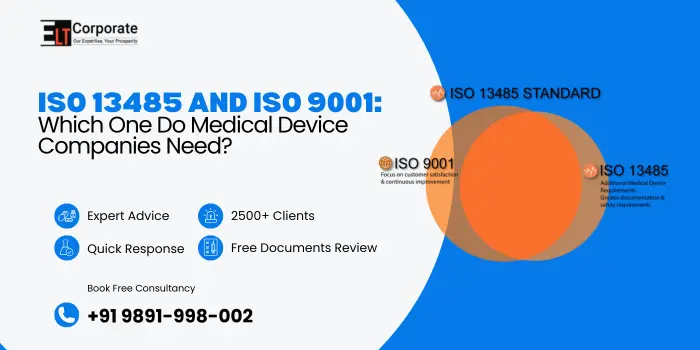When it comes to quality management, ISO certifications play a crucial role in building trust and ensuring safety in manufacturing. For medical device companies, two key standards often come into question – ISO 13485 and ISO 9001.
While both standards focus on quality management, ISO 13485 is specifically designed for the medical device industry, ensuring compliance with regulatory requirements like those of CDSCO (India), FDA (USA), or EU MDR (Europe).
This article will help you understand the difference between ISO 13485 and ISO 9001, their importance, and which one medical device manufacturers actually need.
What Is ISO 9001?
ISO 9001 is a general quality management system (QMS) standard developed by the International Organisation for Standardisation (ISO).
It applies to all industries, focusing on improving processes, efficiency, and customer satisfaction.
Key points of ISO 9001:
- Applicable to all types of organisations (manufacturing, services, etc.)
- Focuses on continuous improvement and customer satisfaction
- Uses the Plan-Do-Check-Act (PDCA) approach for quality improvement
- Does not include product-specific regulatory requirements
For example, a food manufacturer, software developer, or automobile company can all apply ISO 9001 to improve their operations.
What Is ISO 13485?
ISO 13485 is a quality management system standard specifically created for medical device manufacturers and suppliers.
It focuses on product safety, traceability, risk management, and regulatory compliance throughout the product lifecycle – from design to post-market surveillance.
Key points of ISO 13485:
- Tailored for the medical device industry
- Ensures compliance with regulatory frameworks like CDSCO, EU MDR, and FDA
- Focuses on risk management, validation, and documentation control
- Requires strict control of processes and supplier management
This standard ensures that medical devices are safe, effective, and compliant with both international and domestic laws.
What Is the Key Difference Between ISO 13485 and ISO 9001?
While both ISO 13485 and ISO 9001 share a foundation in quality management, they differ in their purpose and application.
Here’s a clear comparison:
ISO 9001:
- Applies to all industries.
- Emphasises customer satisfaction and continuous improvement.
- Flexible structure for general quality improvement.
- Less documentation compared to ISO 13485.
ISO 13485:
- Applies only to medical device companies and their suppliers.
- Focuses on patient safety, product traceability, and risk control.
- Aligns with medical device regulations across multiple countries.
- Involves stringent documentation and validation of every process.
In short, ISO 9001 ensures business efficiency, while ISO 13485 ensures regulatory compliance and device safety.
Do Medical Device Companies Need Both ISO 9001 and ISO 13485?
Most medical device manufacturers need ISO 13485 certification because it directly aligns with regulatory requirements.
However, some companies also choose ISO 9001 if they produce non-medical components or services alongside medical devices.
- If your business only makes medical devices, ISO 13485 is sufficient.
- If your organisation serves multiple industries, having both standards can enhance credibility.
ISO 13485 can also be built upon the ISO 9001 structure, so companies that already have ISO 9001 can easily transition or integrate into ISO 13485.
Why Is ISO 13485 Important for Medical Device Companies?
ISO 13485 is essential because it:
- Ensures product safety and performance in line with regulatory standards.
- Builds global market access, as it is recognized by CDSCO, EU MDR, and US FDA.
- Improves risk management and post-market surveillance.
- Enhances customer trust and brand reputation.
- Helps manufacturers maintain consistent quality throughout the supply chain.
Without ISO 13485 certification, medical device manufacturers may face challenges in export approvals, regulatory audits, and product recalls.
Can ISO 9001 Certification Be Used Instead of ISO 13485 for Medical Devices?
No, ISO 9001 cannot replace ISO 13485 for medical device manufacturers.
ISO 9001 is too generic and does not meet the specific regulatory or safety requirements of the medical device industry. For example, ISO 13485 requires documentation on risk assessment, validation testing, sterile device control, and traceability, which ISO 9001 does not.
Therefore, for compliance with health authorities like CDSCO, ISO 13485 is the mandatory quality standard for medical device businesses.
How to Get ISO 13485 Certification?
The process for obtaining ISO 13485 involves several steps:
- Gap Analysis – Compare current processes with ISO 13485 requirements.
- Documentation – Develop a compliant Quality Manual, SOPs, and validation records.
- Implementation – Apply the QMS across departments and conduct training.
- Internal Audit – Evaluate performance and readiness.
- Certification Audit – Conducted by an accredited certification body.
- Certification Issuance – Once requirements are met, the certificate is granted.
Many organisations partner with compliance consultants or ISO experts to simplify this process.
ISO 13485 and Regulatory Approvals
In India, CDSCO (Central Drugs Standard Control Organisation) often requires ISO 13485 certification for:
- Manufacturing site approval
- Import licensing of medical devices
- Registration under the Medical Device Rules, 2017
Therefore, ISO 13485 acts as a foundation for CDSCO registration, demonstrating that the manufacturer follows international quality management standards.
Is ISO 13485 Mandatory for Medical Device Manufacturers in India?
Yes, for most devices regulated under the Medical Device Rules, 2017, CDSCO requires manufacturers to be ISO 13485 certified.
Can a Company with ISO 9001 Certification Sell Medical Devices?
Not necessarily. ISO 9001 ensures quality management, but doesn’t meet medical device regulatory requirements – ISO 13485 is specifically required for that.


Comments are closed